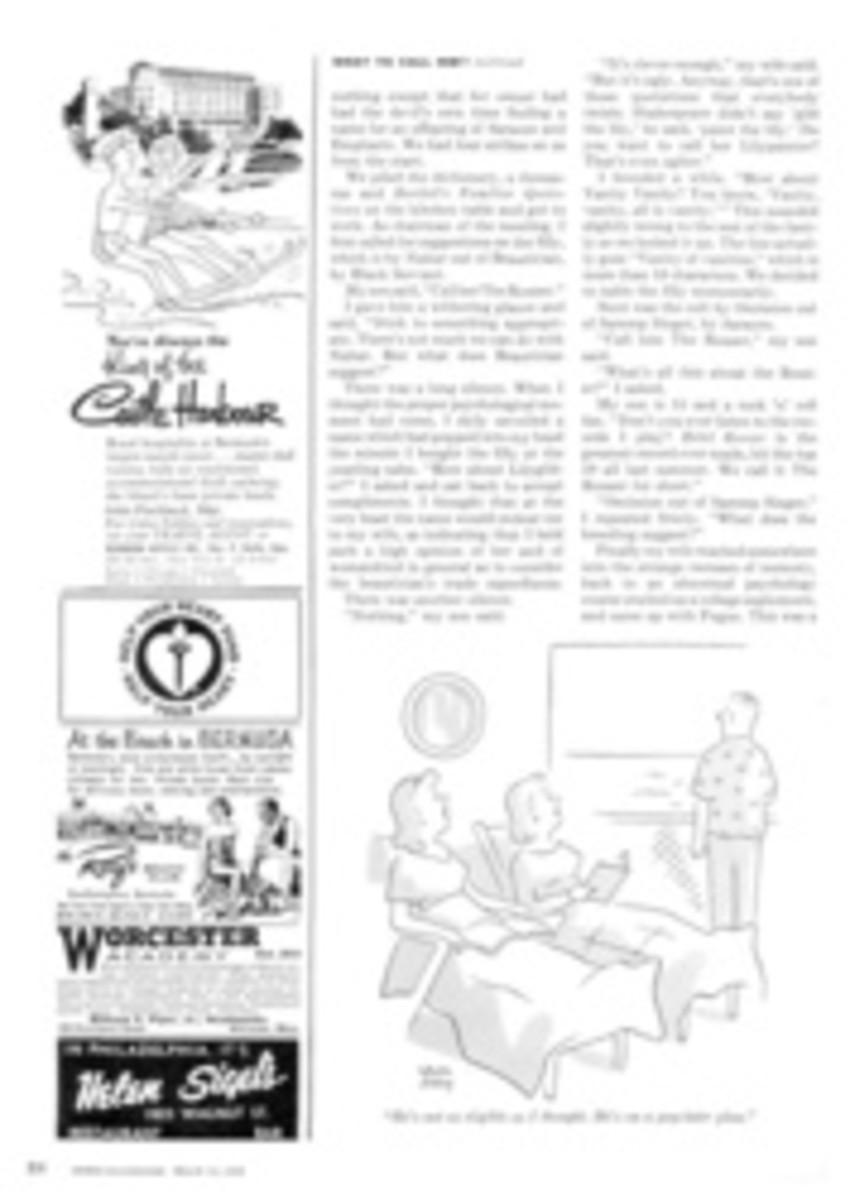
URBANITY AND THE WILDERNESS
An ugly picture of the America of the very near future has just been painted before conservation leaders who journeyed to New York City, more than a thousand strong, for the 24th North American Wildlife Conference and 22 related meetings. This picture is one of a land of vast, sprawling urban complexes containing woefully inadequate green places for outdoor recreation; hardly any space to get out and cool off from the heat generated by the pressures of living in these contiguous cities.
The speakers emphasized how fast this condition is being reached. They told how superhighways, usually built through richer land, are spawning communities and industrial centers along their routes; how the rush to the suburbs results in cities bumping into each other; and how a populace on wheels makes this urban sprawl possible.
Dr. Edward C. Higbee of the University of Delaware said that, unless precautions are taken, whole regions such as that between Boston and Washington are destined to become fused cities and suburbs. David R. Brower, executive director of the Sierra Club in San Francisco, confided that he had been sent to New York on a secret mission—a search for land on which California can resettle its surplus citizens.
"I wish this pretense was as humorous as it is ridiculous," he said. "But it isn't."
Then he added a few brush strokes to the general picture by describing the West Coast freeways and how the suburban sprawl has already spread 30 miles to the south along both sides of San Francisco Bay.
"And if northern California thinks it has a problem, you can pardon southern California for laughing," he said. "Their growth is three times as fast as ours."
He even dropped an arch hint that those earthquakes they have out there are not due to subterranean shifting but are simply caused by the increasing weight of people.
Melvin E. Scheidt, consultant and former director of the Baltimore Regional Planning Council, wielded his brush to paint the metropolitan sprawl in that city. In 1930, he said, Baltimore had 804,000 people, but the four surrounding counties had only 228,000. By 1957 the city's population had increased only to 980,000, but the surrounding counties had grown to 727,000. By 1980 the regional population is expected to reach 2,600,000 and may reach 4,000,000 by the year 2000, even though the city of Baltimore itself is expected to have only 1,300,000 as its ultimate population.
At past meetings speakers have discussed fluctuating animal populations, habitat and life history studies and problems of wildlife management. They still do. At this conference, held at the Statler-Hilton Hotel, they took up everything from "Reliability of Cottontail Censusing" to "Food Habits of Mallards in Louisiana." But now the conservationists have run smack into an explosion—an explosion of the human population. Planners in any of these fields have to keep revising their estimates because of human invasion.
In less than 20 years, said Dr. Higbee, the population of the U.S. has increased by 50 million and there will be 62 million more Americans living here in 1975.
Mr. Brower put it this way:
"In this century the world has used up, and lost forever, more natural resources than in all previous history. And there are now alive, with an unprecedented appetite for resources, 10 per cent of all the men who ever lived on this earth: 25 billion people in the long million years since the dawn of man; 2.5 billion since Yellowstone National Park was created."
In the face of this population explosion it is up to the planners and the legislators to guarantee open spaces for recreation before the urban sprawl gets beyond control. Planning for wise use of the land we have left is needed and needed in a hurry. Said Laurance S. Rockefeller, chairman of the Outdoor Recreation Resources Review Commission, in his first public speech on his organization's plans since the commission was formed last year:
"In creating our commission, the Congress and the President recognized that conservation for physical, cultural and spiritual benefit of the American people is in a critical period of transition as a result of new demands. The unprecedented growth of population, the basic shifts of age groups within the population, the increase in leisure time because of shorter hours and earlier retirement, increasing urbanization and the tremendous strides taken in transportation all lead to the need for re-examination of our outdoor resources and a new appraisal of our requirements, not for just today, but in the terms set out by the act establishing the commission, looking ahead as far as the year 2000."
The commission will take a recreation inventory, evaluate and make comprehensive information and recommendations to the President, the Congress and the individual states and territories. Its findings are to be presented in 1961.
Mr. Rockefeller observed that recreation is still considered by many, including policy makers, as a waste of time.
"We can recognize, as a sign of our reaching maturity as a people," he said, "that this attitude is beginning to change. We are beginning to recognize that outdoor recreation—as a healthy, satisfying and often creative use of leisure time—has evolved from a luxury of the few to a necessity of the many. We must recognize also that sports promotion, travel advertising and the commercial use for outdoor areas have all played a part in accentuating the demand for outdoor facilities."
As his part in the effort to retain future breathing space Mr. Brower made an eloquent plea for the passage of the Wilderness Bill, a measure to insure protection of existing wild areas.
"We work hard, with a sense of urgency," he said. "The wilderness we now have is all the wilderness we shall ever have in America. There is little left—less than one-third acre per person in the U.S. if you count all the wilderness that has any administrative protection in our national parks and forests and wildlife refuges and on Indian lands. One-third of an acre per person today; less per person as our population expands still further; all of it subject to being struck out by an administrator's pen."
Monroe Bush, of the Old Dominion Foundation in Washington, D.C., added a grimmer shade to the picture when he said, "We cannot honestly pretend that the American people, as a people, have a conservation conscience."
Faced with this appalling urban sprawl and rural shrinkage and confronted by the looming prospect of these great pools of population with scarcely any green spaces in which to enjoy the relaxation and fun for which most of us work, it is obvious to us that the American people had better heed these experts—had better rise up on their hind legs and give voice to a conservation conscience. And they had better do it in a hurry, for time, as well as the land, is a-wasting.
"Between 1950 and 1956, the nation's population increased by 15 million. Of these, 13 million were in the areas which contain the largest cities and their environs."
"The disappearance of farmland in the environs of cities is estimated at approximately one half million acres each year."
"When man obliterates wilderness, he repudiates the evolutionary force that put him on this planet. In a deep and terrifying sense, man is on his own."
"Some fifteen years ago, a writer friend of mine, seeking peace and quiet, built a home in the desert, west of Albuquerque. Today his house is in the middle of a bustling suburban community."

